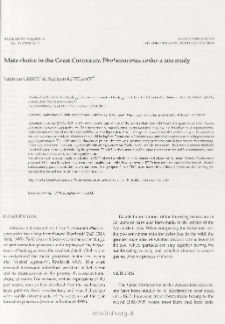
Obiekt
Tytuł: Mate choice in the great cormorant Phalacrocorax carbo: a zoo study
Twórca:
Grieco, Fabrizio (1969– ) ; Kortlandt, Adriaan (1918–2009)
Data wydania/powstania:
Typ zasobu:
Inny tytuł:
Acta Ornithologica, vol. 35, no. 1 ; Wybór partnera u kormoranów w warunkach ogrodu zoologicznego
Współtwórca:
Polska Akademia Nauk. Muzeum i Instytut Zoologii ; Meeting of the European Ornithologists' Union (2 ; 1999 ; Gdańsk)
Wydawca:
Muzeum i Instytut Zoologii PAN
Miejsce wydania:
Opis:
Referat wygłoszony na Second Meeting of the European Ornithologists' Union ; Bibliogr. s. 78 ; S. [73]-78 : il. ; 27 cm ; Streszcz. pol.
Typ obiektu:
Abstrakt:
Study (1982-1997) in the small cormorants' colony of the Amsterdam Zoo addressed the question of what factors determine between-season divorce. The proportion of pairs splitting up the next year was 0.46, i.e. less than in wild populations. Low divorce rate could not be explained by the small population size. Computer simulations showed that if pair-formation in the zoo occurred at random, divorce rate would be higher. Occurrence of divorce was unrelated to previous breeding success or age of pair mates. The only variable that could predict divorce was the frequency of interactions of pair mates after breeding. Pair mates that were not seen together after breeding were more likely to split up the next year. Thus mate retention probably involved some process of choice by the partners. This led to the suggestion that mate retention in the wild is constrained, since contact between mates is lost during migration. We also found that extra-pair copulations (EPCs) played a role in the assessment and choice of the mate. Female Cormorants pursued EPCs mostly when they were presumably not fertile. Involvement in EPCs increased the probability that the female subsequently paired with the male concerned. It is proposed that EPCs may have the additional function of assessing the quality of potential mates for future pair-formation.
Czasopismo/Seria/cykl:
Tom:
Zeszyt:
Strona pocz.:
Strona końc.:
Szczegółowy typ zasobu:
Artykuł ; Materiały konferencyjne
Format:
Identyfikator zasobu:
Źródło:
MiIZ PAN, patrz sygn. czas. P.257, Vol. 35, No 1 ; MiIZ PAN, patrz sygn. czas. P.4568, Vol. 35, No 1 ; kliknij tutaj, żeby przejść
Język:
Prawa:
Prawa zastrzeżone - dostęp ograniczony
Zasady wykorzystania:
Digitalizacja:
Muzeum i Instytut Zoologii Polskiej Akademii Nauk
Lokalizacja oryginału:
Biblioteka Muzeum i Instytutu Zoologii PAN
Dofinansowane ze środków:
Program Operacyjny Innowacyjna Gospodarka, lata 2010-2014, Priorytet 2. Infrastruktura strefy B + R ; Unia Europejska. Europejski Fundusz Rozwoju Regionalnego
Dostęp:
Kolekcje, do których przypisany jest obiekt:
- Repozytorium Cyfrowe Instytutów Naukowych > Kolekcje Partnerów > Muzeum i Instytut Zoologii PAN > Czasopisma
- Repozytorium Cyfrowe Instytutów Naukowych > Kolekcje Partnerów > Muzeum i Instytut Zoologii PAN > Wydawnictwa MiIZ PAN > Acta Ornithologica
- Repozytorium Cyfrowe Instytutów Naukowych > Piśmiennictwo > Czasopisma/Artykuły
Data ostatniej modyfikacji:
2 paź 2020
Data dodania obiektu:
22 maj 2014
Liczba pobrań / odtworzeń:
142
Wszystkie dostępne wersje tego obiektu:
https://rcin.org.pl/publication/61267
Wyświetl opis w formacie RDF:
Wyświetl opis w formacie RDFa:
Wyświetl opis w formacie OAI-PMH:
| Nazwa wydania | Data |
|---|---|
| Mate choice in the great cormorant Phalacrocorax carbo: a zoo study / Grieco, Fabrizio (1969- ) | 2 paź 2020 |
Obiekty Podobne
Stempniewicz, Lech (1949– ) Goc, Michał (1949– ) Bzoma, Szymon Nitecki, Czesław Iliszko, Lech
Grieco, Fabrizio (1969– )
Kopij, Grzegorz
Kéler, Stefan von (1897–1967)
Zbyryt, Adam Kapowicz, Edyta Bzoma, Szymon
Jenni, Lukas
Bujalska, Gabriela
Lebreton, Jean-Dominique (1950– )

 INSTYTUT ARCHEOLOGII I ETNOLOGII POLSKIEJ AKADEMII NAUK
INSTYTUT ARCHEOLOGII I ETNOLOGII POLSKIEJ AKADEMII NAUK
 INSTYTUT BADAŃ LITERACKICH POLSKIEJ AKADEMII NAUK
INSTYTUT BADAŃ LITERACKICH POLSKIEJ AKADEMII NAUK
 INSTYTUT BADAWCZY LEŚNICTWA
INSTYTUT BADAWCZY LEŚNICTWA
 INSTYTUT BIOLOGII DOŚWIADCZALNEJ IM. MARCELEGO NENCKIEGO POLSKIEJ AKADEMII NAUK
INSTYTUT BIOLOGII DOŚWIADCZALNEJ IM. MARCELEGO NENCKIEGO POLSKIEJ AKADEMII NAUK
 INSTYTUT BIOLOGII SSAKÓW POLSKIEJ AKADEMII NAUK
INSTYTUT BIOLOGII SSAKÓW POLSKIEJ AKADEMII NAUK
 INSTYTUT CHEMII FIZYCZNEJ PAN
INSTYTUT CHEMII FIZYCZNEJ PAN
 INSTYTUT CHEMII ORGANICZNEJ PAN
INSTYTUT CHEMII ORGANICZNEJ PAN
 INSTYTUT FILOZOFII I SOCJOLOGII PAN
INSTYTUT FILOZOFII I SOCJOLOGII PAN
 INSTYTUT GEOGRAFII I PRZESTRZENNEGO ZAGOSPODAROWANIA PAN
INSTYTUT GEOGRAFII I PRZESTRZENNEGO ZAGOSPODAROWANIA PAN
 INSTYTUT HISTORII im. TADEUSZA MANTEUFFLA POLSKIEJ AKADEMII NAUK
INSTYTUT HISTORII im. TADEUSZA MANTEUFFLA POLSKIEJ AKADEMII NAUK
 INSTYTUT JĘZYKA POLSKIEGO POLSKIEJ AKADEMII NAUK
INSTYTUT JĘZYKA POLSKIEGO POLSKIEJ AKADEMII NAUK
 INSTYTUT MATEMATYCZNY PAN
INSTYTUT MATEMATYCZNY PAN
 INSTYTUT MEDYCYNY DOŚWIADCZALNEJ I KLINICZNEJ IM.MIROSŁAWA MOSSAKOWSKIEGO POLSKIEJ AKADEMII NAUK
INSTYTUT MEDYCYNY DOŚWIADCZALNEJ I KLINICZNEJ IM.MIROSŁAWA MOSSAKOWSKIEGO POLSKIEJ AKADEMII NAUK
 INSTYTUT PODSTAWOWYCH PROBLEMÓW TECHNIKI PAN
INSTYTUT PODSTAWOWYCH PROBLEMÓW TECHNIKI PAN
 INSTYTUT SLAWISTYKI PAN
INSTYTUT SLAWISTYKI PAN
 SIEĆ BADAWCZA ŁUKASIEWICZ - INSTYTUT TECHNOLOGII MATERIAŁÓW ELEKTRONICZNYCH
SIEĆ BADAWCZA ŁUKASIEWICZ - INSTYTUT TECHNOLOGII MATERIAŁÓW ELEKTRONICZNYCH
 MUZEUM I INSTYTUT ZOOLOGII POLSKIEJ AKADEMII NAUK
MUZEUM I INSTYTUT ZOOLOGII POLSKIEJ AKADEMII NAUK
 INSTYTUT BADAŃ SYSTEMOWYCH PAN
INSTYTUT BADAŃ SYSTEMOWYCH PAN
 INSTYTUT BOTANIKI IM. WŁADYSŁAWA SZAFERA POLSKIEJ AKADEMII NAUK
INSTYTUT BOTANIKI IM. WŁADYSŁAWA SZAFERA POLSKIEJ AKADEMII NAUK


































